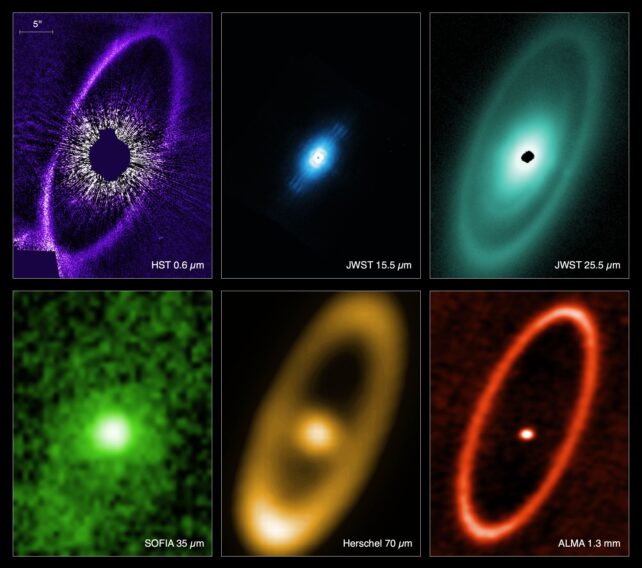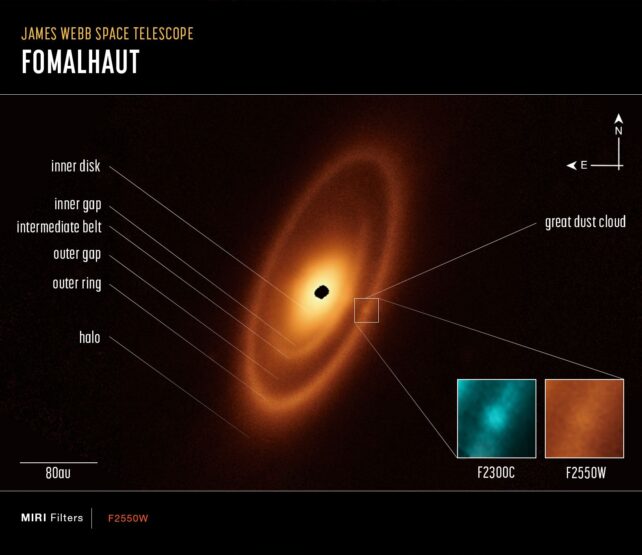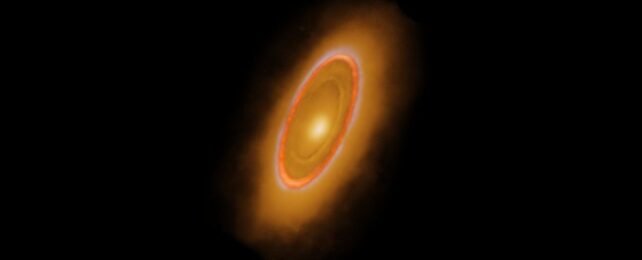A closer look at an intriguing star just 25 light-years away has revealed a much more complex architecture of debris than earlier observations had suggested.
Using the James Webb Space Telescope, astronomers have found that the star named Fomalhaut – home to one of the first asteroid belts discovered outside the Solar System – is actually orbited by a nested series of three concentric belts, extending out to a distance of 150 astronomical units.
These debris fields around the young star could help astronomers piece together the processes involved in planetary formation and the dynamics of a young planetary system, leading to a better understanding of how our own Solar System came into being.
"I would describe Fomalhaut as the archetype of debris disks found elsewhere in our galaxy, because it has components similar to those we have in our own planetary system," says astronomer András Gáspár of the University of Arizona. "By looking at the patterns in these rings, we can actually start to make a little sketch of what a planetary system ought to look like – If we could actually take a deep enough picture to see the suspected planets."

Fomalhaut is a very interesting object to study in this context. It's around 440 million years old; a mere toddler in stellar lifespans. Yet it's a relatively familiar size star, around 1.92 times the mass and 1.84 times the radius of our own Sun. It burns hot and bright, and its light suggests there's a lot of dust in the space around it. Previous observations using powerful instruments such as Hubble and ALMA revealed the presence of a large asteroid belt around it, similar to the Kuiper Belt in the outer Solar System, but further details were too dim to resolve.
Another interesting tidbit about Fomalhaut was the discovery of a putative gas giant exoplanet in Hubble images taken in 2004 and 2006, with confirmation occuring in 2012. Named Dagon, this exoplanet was one of the rare few to be imaged directly.
But then Dagon vanished. A team led by Gáspár determined in 2020 that Dagon had never actually been; the object spotted by Hubble was an expanding dust cloud produced by a collision between two asteroids that pulverized each other.
This suggests that there's actually rather a lot going on in the Fomalhaut system, so Gáspár and his colleagues used the most powerful space telescope ever deployed to take a closer look. They studied the space around the star using JWST's mid-infrared instrument, and found disks of material interior to the known outer ring.
Now, dust is common around very young stars. Once the star has finished forming, the disk of dust and gas spooling into it remains and starts clumping together to form planets. But that is not what we're looking at with Fomalhaut. Rather, the nested asteroid belts are what are known as debris disks: belts of material with very little gas that result from collisions between planetesimals, objects such as asteroids and comets that then orbit as a ring of dust and rubble.
The debris disks around Fomalhaut could be revealing an even more complex story than that, though. There are distinct gaps between the rings, which suggests the presence of unseen planets gravitationally carving out paths among the dust.

"Where Webb really excels is that we're able to physically resolve the thermal glow from dust in those inner regions. So you can see inner belts that we could never see before," says astronomer Schuyler Wolff of the University of Arizona.
"We definitely didn't expect the more complex structure with the second intermediate belt and then the broader asteroid belt. That structure is very exciting because any time an astronomer sees a gap and rings in a disk, they say, 'There could be an embedded planet shaping the rings!'"
The team's research also revealed, embedded in the outer ring, a structure they are calling the great dust cloud, likely the product of another relatively recent collision between planetesimals. And the belt in the middle is probably the place where Dagon (currently speeding away from Fomalhaut on an exit trajectory out of the system) originated. This suggests that the belts are pretty turbulent places, and that we have a lot to learn about baby planetary systems from Fomalhaut.
"The belts around Fomalhaut are kind of a mystery novel: Where are the planets?" says astronomer George Rieke of the University of Arizona.
"I think it's not a very big leap to say there's probably a really interesting planetary system around the star."
The research has been published in Nature Astronomy.
